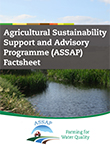
Early Nitrogen for Spring Grassland
Early Nitrogen for Spring Grassland 23 March 2021 Type Factsheet There is a high risk of nitrate leaching from free draining grassland fields in early spring. Farmers can help reduce these losses by carefully managing fertiliser applications and using good Nutrient Management Planning practices. This factsheet was produced as part of a series of factsheets […]
By There is a high risk of nitrate leaching from free draining grassland fields in early spring. Farmers can help reduce these losses by carefully managing fertiliser applications and using good Nutrient Management Planning practices. This factsheet was produced as part of a series of factsheets by the Agricultural Sustainability Support and Advisory Programme (ASSAP).

Early Nitrogen for Spring Grassland
Type Factsheet
There is a high risk of nitrate leaching from free draining grassland fields in early spring. Farmers can help reduce these losses by carefully managing fertiliser applications and using good Nutrient Management Planning practices. This factsheet was produced as part of a series of factsheets by the Agricultural Sustainability Support and Advisory Programme (ASSAP).
Download Publication (PDF)
Tips when applying early Spring Nitrogen
- Only spread if fields are suitable for tractor work, when water is drained sufficiently and and where heavy rainfall is not forecast. Apply fertiliser N when soil temperature is greater than 6°C and rising. Typically this occurs around the end of February however, this will vary across the country and from year to year.
- Target fields for early N that are most likely to respond to an early N application: fields at optimum soil fertility (pH, P and K), perennial ryegrass swards, recently reseeded or with a grass cover of greater than 400 kg DM/ha or 5 cm grass.
- Match chemical N applied to grass growth rates as this varies across the country. Apply up to 30kg N/ha (24 units N/ha) maxiumum in 1st split and avoid fields that have received an application of cattle slurry.
- Applying slurry in spring – 25 m³/ha (2,500 gals/ac) by low emission application will supply ~25 kg/ha (~20 units/ac) of available N. It is important to reduce your chemical N application rates accordingly.
- To ensure efficient and accurate application of fertiliser, calibrate fertiliser spreaders and use GPS equipment where available
- Use protected urea for early N applications as this will help reduce the risk of nitrate leaching
Summary
There is a high risk of nitrate leaching from free draining grassland fields in early spring and the autumn/winter period of the year due to low grass growth rates and high rainfall levels. Farmers can help reduce these losses by carefully managing fertiliser applications and using good Nutrient Management Planning practices. Improved utilisation of chemical nitrogen on grassland will improve the financial return to the farmer but also reduce the risk to water quality.
For more information please visit www.teagasc.ie/water-quality or view the rest of the factsheets in the series here
